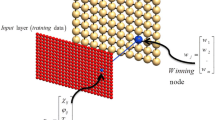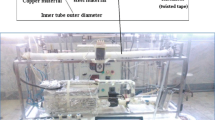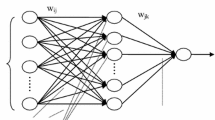Abstract
The purpose of this study was to investigate the efficiency of using magnesium oxide nanoparticles, twisted tapes with different and modified twist ratios, and the different rotation velocity of perforated twisted tapes in the evaluation of Nusselt number, overall heat transfer coefficient and pressure drop in a double pipe heat exchanger. Subsequently, the results obtained from the experimental tests of Nusselt number, overall heat transfer coefficient and pressure drop using a modified twisted tape in a double pipe heat exchanger and a back propagation artificial neural network with a multilayered perceptron structure show the existence of a relationship between heat transfer parameters and input data such as cold and hot fluid temperatures, volume fractions of nanofluid, twisted tapes of different twist ratios, the rotation velocity of twisted tapes, Reynolds number of hot and cold fluids, viscosity and thermal conductivity of the nanofluid. Also, the non-monitored artificial neural network selected 33 neurons for use in the multilayered perceptron neural network. The network included the sigmoid function in the hidden layer and the Levenberg–Marquardt training algorithm with a three-layer topology of 9–33-1 with the correlation coefficients of 0.9987, 0.9933 and 0.9944 and the mean squared error of 0.66535, 4547.68 and 0.008768. This network was best for predicting heat transfer parameters such as Nusselt number, overall heat transfer coefficient and pressure drop.



























Similar content being viewed by others
Abbreviations
- U:
-
Overall heat transfer coefficient (W m-2oC−1)
- Nu:
-
Nusselt number
- emax :
-
Maximum error
- BPANN:
-
Back propagation artificial neural network
- MLP:
-
Multilayered perceptron structure
- MSE:
-
Mean squared error
- ML:
-
Levenberg–Marquardt
- ANN:
-
Artificial neural network
- SOM:
-
Self-organizing map
References
Hasanpour A, Farhadi M, Sedighi K (2017) Intensification of heat exchangers performance by modified and optimized twisted tapes. Chem Eng Process Process Intensif 120:276–285
Hong Y, Du J, Wang S (2017) turbulent thermal, fluid flow and thermodynamic characteristics in a plain tube fitted with overlapped multiple twisted tapes. Int J Heat Mass Transf 115:551–565
Man C, Lv X, Hu J, Sun P, Tang Y (2017) Experimental study on effect of heat transfer enhancement for single-phase forced convective flow with twisted tape inserts. Int J Heat Mass Transf 106:877–883
Esfe MH, Nadooshan AA, Arshi A, Alirezaie A (2018) Convective heat transfer and pressure drop of aqua based TiO2 nanofluids at different diameters of nanoparticles: Data analysis and modeling with artificial neural network. Physica E: Low-dimensional Systems and Nanostructures 97:155–161
Esfe MH (2017) Designing a neural network for predicting the heat transfer and pressure drop characteristics of Ag/water nanofluids in a heat exchanger. Appl Therm Eng 126:559–565
Asadi A, Asadi M, Rezaniakolaei A, Rosendahl LA, Afrand M, Wongwises S (2018) Heat transfer efficiency of Al2O3-MWCNT/thermal oil hybrid nanofluid as a cooling fluid in thermal and energy management applications: An experimental and theoretical investigation. Int J Heat Mass Transf 117:474–486
Amani M, Amani P, Jumpholkul C, Mahian O, Wongwises S (2018) Hydrothermal optimization of SiO2/water nanofluids based on attitudes in decision making. International Communications in Heat and Mass Transfer 90:67–72
Esfe MH, Hajmohammad H, Toghraie D, Rostamian H, Mahian O, Wongwises S (2017) Multi-objective optimization of nanofluid flow in double tube heat exchangers for applications in energy systems. Energy 137:160–171
Kumar N, Sonawane SS, Sonawane SH (2018) Experimental study of thermal conductivity, heat transfer and friction factor of Al2O3 based nanofluid. International Communications in Heat and Mass Transfer 90:1–10
Tafarroj M, Mahian O, Kasaeian Sakamatapan K, Dalkilic AS, Wongwises S (2017) Artificial neural network modeling of nanofluid flow in a microchannel heat sink using experimental data. International Communications in Heat and Mass Transfer 86:25–31
Ghasemi N, Aghayari R, Maddah H (2017) Designing an artificial neural network using radial basis function to model exergetic efficiency of nanofluids in mini double pipe heat exchanger. Heat and Mass Transfer 1–13
Maddah H, Ghasemi N (2017) Experimental evaluation of heat transfer efficiency of nanofluid in a double pipe heat exchanger and prediction of experimental results using artificial neural networks. Heat and Mass Transfer 1–14
Koçyigit N, Bulgurcu H (2018) Modeling of overall heat transfer coefficient of a concentric double pipe heat exchanger with limited experimental data by using curve fitting and artificial neural network combination. Thermal Science 111
Thukaram D, Kamalasadan S, Ghandakly AA (2003) Matlab based artificial neural network algorithm for voltage stability assessment
Vedaldi A, Lenc K (2015) Matconvnet: Convolutional neural networks for matlab. In: Proceedings of the 23rd ACM international conference on Multimedia (pp. 689–692), ACM
Sivanandam SN, Deepa SN (2006) Introduction to neural networks using Matlab 6.0. Tata McGraw-Hill Education, India
Qi C, Wang G, Yan Y, Mei S, Luo T (2018) Effect of rotating twisted tape on thermo-hydraulic performances of nanofluids in heat-exchanger systems. Energy Convers Manag 166:744–757
Prasad PD, Gupta AVSSKS, Deepak K (2015) Investigation of trapezoidal-cut twisted tape insert in a double pipe u-tube heat exchanger using Al2O3/water nanofluid. Procedia Mater Sci 10:50–63
Sarviya RM, Fuskele V (2018) Heat transfer and pressure drop in a circular tube fitted with twisted tape insert having continuous cut edges. Journal of Energy Storage 19:10–14
Maddah H, Aghayari R, Ahmadi MH, Rahimzadeh M, Ghasemi N (2018) Prediction and modeling of MWCNT/Carbon (60/40)/SAE 10 W 40/SAE 85 W 90 (50/50) nanofluid viscosity using artificial neural network (ANN) and self-organizing map (SOM). J Therm Anal Calorim:1–12
Hojjat M (2018) Modeling heat transfer of non-Newtonian nanofluids using hybrid ANN-Metaheuristic optimization algorithm. Journal of Particle Science & Technology 3(4):233–241
Abdollahi-Moghaddam M, Motahari K, Rezaei A (2018) Performance characteristics of low concentrations of CuO/water nanofluids flowing through horizontal tube for energy efficiency purposes; an experimental study and ANN modeling. J Mol Liq 271:342–352
Naphon P, Wiriyasart S, Arisariyawong T (2018) Artificial neural network analysis the pulsating Nusselt number and friction factor of TiO 2/water nanofluids in the spirally coiled tube with magnetic field. Int J Heat Mass Transf 118:1152–1159
Author information
Authors and Affiliations
Corresponding author
Additional information
Publisher’s note
Springer Nature remains neutral with regard to jurisdictional claims in published maps and institutional affiliations.
Rights and permissions
About this article
Cite this article
Ghasemi, N., Maddah, H., Mohebbi, M. et al. Proposing a method for combining monitored multilayered perceptron (MLP) and self-organizing map (SOM) neural networks in prediction of heat transfer parameters in a double pipe heat exchanger with nanofluid. Heat Mass Transfer 55, 2261–2276 (2019). https://doi.org/10.1007/s00231-019-02576-3
Received:
Accepted:
Published:
Issue Date:
DOI: https://doi.org/10.1007/s00231-019-02576-3




